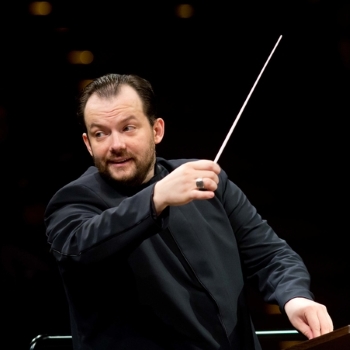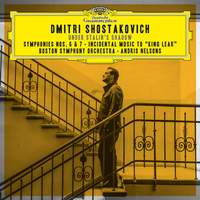Recording of the Week,
Andris Nelsons continues his Shostakovich cycle with Symphonies 6 & 7
Andris Nelsons's ongoing Boston cycle of Shostakovich symphonies has maintained such high standards that it might seem somewhat predictable that every single volume so far ends up being featured as our Presto Recording of the Week. And yet it's never a foregone conclusion: within about two minutes of listening to any new instalment that comes along, it becomes perfectly clear that yes, we're going to need to write about this one too!
 One of the bonuses of Nelsons's cycle has been that he has often included some of Shostakovich's shorter works alongside the symphonies. Here we are given a suite of music from a 1940 production of King Lear. There's much to enjoy: I loved the pomp of the Return from the Hunt procession and the ominous brass during the Approach of the Storm.
One of the bonuses of Nelsons's cycle has been that he has often included some of Shostakovich's shorter works alongside the symphonies. Here we are given a suite of music from a 1940 production of King Lear. There's much to enjoy: I loved the pomp of the Return from the Hunt procession and the ominous brass during the Approach of the Storm.
A much more familiar piece is the Festive Overture. Popular visitor to the concert hall as it is, it would be easy to dismiss it as a mere frivolity, but I was pleased that Nelsons treats it with just as much respect as the symphonies, with beautifully balanced, crisp trumpet fanfares, immaculate precision of clarinet and piccolo semiquavers, and boisterous crescendos from lower brass.
And so to the main course: the Seventh Symphony. The focal point of its first movement is the extended central section where Shostakovich repeats a deliberately banal tune ad infinitum, starting extremely quietly and gradually building in volume and intensity, all the while accompanied, Bolero-like, by the relentless rhythm of a side drum.
Much like the Festive Overture, it would be easy to let it play itself without worrying too much about the detail. After all, with its continual addition of instruments and increasing of fervency it can hardly fail to be a thrilling experience, and yet with the care and attention that he pays to the tiniest nuances of Shostakovich's orchestration, Nelsons once again demonstrates why this series has been so consistently successful. For example, the melody is first introduced by upper strings in unison. All well and good, only it's not quite that simple: although their notes are the same, the first violins play them bowed as normal, while the violas play pizzicato, and the second violins are instructed to play col legno, i.e. tapping the strings with the wood of the bow rather than the hair. Here I could clearly pick out the distinct timbres of the different techniques, with the percussive pluck of the violas contrasting pleasingly with the skeletal click of the second violins.
Perhaps I'm dwelling too much on such a minuscule point, and yet hundreds of tiny moments like this one add up to an extremely satisfying whole; from the voicing of the trumpet and trombones' contrary motion scales to the exquisite delicacy of the double basses' subterranean slitherings, it's a pleasure to behold. Not once did I feel that the melody had outstayed its welcome; it became instead an hypnotic, mesmerising tune that I could quite happily have listened to for another dozen repetitions!
It almost goes without saying that the playing from the Boston Symphony Orchestra is of the highest quality, with highlights being the raucous clarinet interruption during the second movement, or the bleak woodwind at the start of the third movement giving way to impassioned violins. In addition to the standard orchestral forces, Shostakovich calls for extra brass groups, and when they kick in towards the very end of the symphony it's quite magnificent. The final few minutes can often turn into a relentless cacophony of sound, and yet this performance has been so expertly recorded and balanced that even when the brass were in full flow, I could still hear detail in the woodwind and strings, and the last few great wallops from timpani and bass drum before the final C major chord are exactly as thumpingly visceral as I had hoped they would be. Wonderful!
Boston Symphony Orchestra, Andris Nelsons
Available Formats: 2 CDs, MP3, FLAC, Hi-Res FLAC



